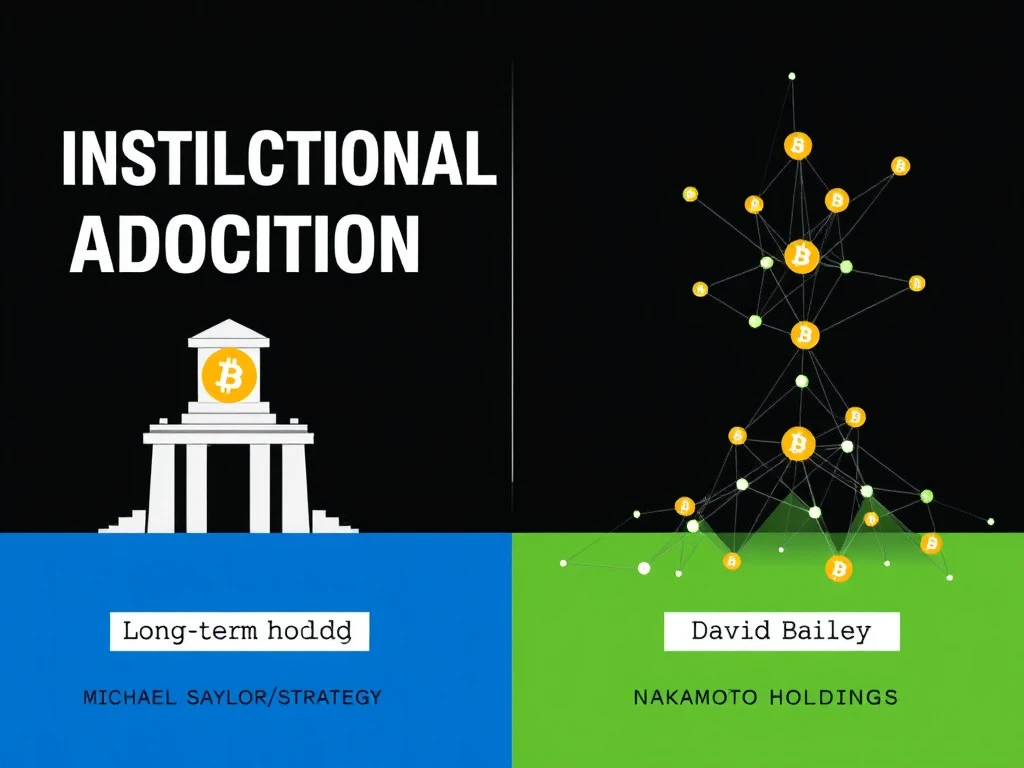Institutional Bitcoin Adoption: Michael Saylor vs. David Bailey’s Innovative Paths

The landscape of corporate finance is changing. What began as a speculative venture for some early adopters has evolved into a serious consideration for large companies and institutions: Institutional Bitcoin Adoption. Two prominent figures, Michael Saylor and David Bailey, are leading this charge, albeit through distinct methods.
Michael Saylor’s Long-Term Bitcoin Treasury Strategy
Michael Saylor, through MicroStrategy (now Strategy), is widely recognized for pioneering the corporate Bitcoin Treasury Strategy. Starting in 2020, the company began allocating significant capital to Bitcoin, a move that has since defined its corporate identity. As of May 2025, Strategy holds a substantial amount of BTC, acquired primarily by raising capital through preferred stock offerings and using the proceeds to buy more Bitcoin. Saylor views Bitcoin as a superior form of capital, a long-term store of value resistant to traditional inflation.
His approach is characterized by a strong conviction in Bitcoin’s future, envisioning it as a global settlement network for major financial players and even AI. This perspective has led some investors to treat Strategy stock as a proxy for Bitcoin exposure, often seeing amplified price movements compared to BTC itself.
The HODL Philosophy in Practice
Saylor embodies the ‘hodling’ philosophy – buying and holding Bitcoin regardless of market volatility. This strategy is based on the belief that Bitcoin’s long-term growth trajectory outweighs short-term price fluctuations. Unlike trading, which attempts to time the market, hodling is a bet on Bitcoin’s fundamental value proposition over extended periods. Market history shows that consistently holding assets like Bitcoin can often outperform active trading strategies, which are susceptible to emotional decision-making during downturns.
This long-term holding is not unique to Strategy. Major financial institutions like Fidelity, BlackRock, and ARK Invest manage Bitcoin spot ETFs that also employ a buy-and-hold approach. Onchain data supports this trend, showing a significant portion of Bitcoin’s supply remaining untouched for a year or more, indicating a strong holder base.
David Bailey’s Dynamic Approach to Corporate Bitcoin Holdings
David Bailey, CEO of BTC Inc and Bitcoin Magazine, represents a different path to institutional engagement. After years at the center of Bitcoin media, Bailey is now building a conglomerate aimed at integrating capital markets, advisory services, and public companies within a Bitcoin-native structure. His investment vehicle, Nakamoto Holdings, recently merged with publicly listed KindlyMD, creating a path to public markets and raising substantial capital, much of which is allocated to Bitcoin.
Bailey’s vision is to create a diversified entity akin to historical financial houses, combining media, merchant banking, and holding company functions. While also accumulating Corporate Bitcoin Holdings, Bailey’s strategy is more dynamic than Saylor’s. He has indicated openness to potentially selling Bitcoin at market highs for strategic purposes, such as buying back shares or funding acquisitions, provided the action ultimately increases the amount of BTC held per share over time. This suggests a willingness to be more active in managing the treasury compared to Saylor’s purely accumulative model.
Comparing Saylor and Bailey: Different Paths, Same Goal?
Both Michael Saylor and David Bailey are committed to integrating Bitcoin into the traditional financial and corporate world. However, their methods differ:
- **Saylor (Strategy):** Primarily focused on large-scale, continuous accumulation of Bitcoin using capital raises. The strategy is largely passive holding, treating BTC as a long-term reserve asset.
- **Bailey (Nakamoto Holdings):** Building a more diversified conglomerate integrating media, advisory, and capital functions. While also accumulating Bitcoin, the approach is more dynamic, open to strategic reallocation of BTC for corporate growth, aiming to increase BTC per share over time.
Saylor’s model emphasizes deep conviction and passive accumulation, while Bailey’s focuses on building an interconnected ecosystem where Bitcoin is both a treasury asset and a tool for corporate strategy and growth. Both approaches aim to institutionalize Bitcoin, creating structured entities with long-term capital frameworks and public market participation.
The Expanding Trend of Corporate Bitcoin Holdings
The strategies of Saylor and Bailey are part of a growing trend. Corporate Bitcoin holdings have increased significantly since 2020, now representing a notable percentage of the total supply. Recent examples in May 2025 highlight this trend:
- GameStop disclosed a substantial purchase of BTC, entering the digital asset space.
- Trump Media & Technology Group announced plans for a large capital raise specifically to establish a Bitcoin treasury.
- Other firms like The Blockchain Group have also increased their BTC holdings, sometimes correlating with positive stock performance.
These developments follow earlier moves by publicly listed companies like Block, Tesla, and Coinbase. As more corporations adopt a Bitcoin Treasury Strategy, the available supply of Bitcoin for new buyers tightens. This supply constraint, combined with increasing interest from institutional investors via spot ETFs, reinforces Bitcoin’s perception as a strategic, long-term asset. The efforts of figures like Saylor and Bailey are instrumental in solidifying Bitcoin’s role in corporate finance globally.
Conclusion: Shaping Bitcoin’s Institutional Future
Michael Saylor and David Bailey represent two powerful forces driving Institutional Bitcoin Adoption. Saylor’s steadfast accumulation and HODL philosophy have demonstrated the viability of Bitcoin as a primary corporate treasury asset. Bailey’s dynamic approach, building a diversified, Bitcoin-native conglomerate, showcases how Bitcoin can be integrated into a broader corporate strategy. While their methods differ, both are creating blueprints for how traditional finance and corporations can engage with Bitcoin on a significant scale. As more companies follow suit, the impact on Bitcoin’s market structure and its role in the global economy will continue to grow, validating these pioneering strategies.









